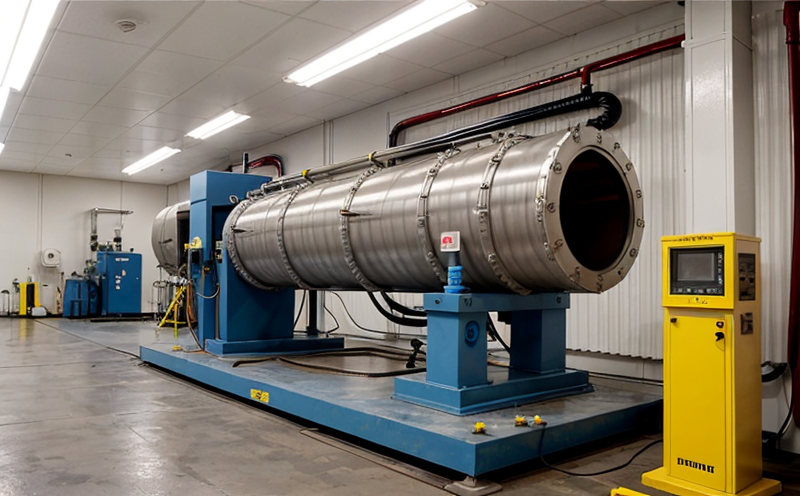ISO 12187 Curium Isotopic Testing
The ISO 12187 standard provides a comprehensive framework for determining the isotopic composition of curium, which is crucial in various sectors including nuclear fuel and isotope production. This testing ensures that nuclear materials meet specified purity levels and are suitable for their intended applications. The process involves precise measurement techniques to quantify the relative abundances of different curium isotopes such as 242Cm, 243Cm, and others.
The importance of this testing cannot be overstated in ensuring nuclear safety and compliance with international regulations. In the context of nuclear fuel manufacturing, accurate isotopic composition is vital for optimizing reactor performance and minimizing waste generation. For isotope production facilities, such precision ensures that products meet stringent quality standards required by end-users.
The testing procedure typically begins with sample preparation, which may involve dissolution of the material in a suitable solvent followed by purification to remove impurities. The purified solution is then loaded onto an isotopic separation column where individual isotopes are fractionated based on their chemical properties. Following this step, the separated fractions undergo further analysis using high-resolution mass spectrometry (HRMS) or other advanced analytical techniques.
The HRMS system used in our laboratory employs quadrupole and time-of-flight detectors for enhanced resolution and sensitivity. This allows us to detect even trace amounts of curium isotopes with high precision. Once the data is collected, it undergoes rigorous validation checks to ensure accuracy before being reported according to ISO 12187 guidelines.
One key aspect of this testing is understanding the environmental impact associated with handling radioactive materials. Our lab adheres strictly to all safety protocols outlined in IAEA recommendations and national regulations to minimize risks both for personnel and the environment. By providing accurate isotopic compositions, we contribute significantly towards safer nuclear operations worldwide.
In summary, ISO 12187 curium isotopic testing is an essential service that supports critical applications across multiple industries by ensuring consistency in product quality and adherence to regulatory requirements. Our expertise lies not only in executing these tests accurately but also in interpreting results effectively so clients can make informed decisions regarding their projects.
Applied Standards
| Standard Number | Description |
|---|---|
| ISO 12187-1:2005 | General requirements for the determination of isotopic composition in actinides and their compounds. |
| ISO 12187-3:2014 | Determination of isotopic composition by instrumental neutron activation analysis (INAA). |
| ISO/IEC 17025:2017 | General requirements for the competence of testing and calibration laboratories. |
| IAEA TECDOC-1683 | Advanced Techniques for Isotopic Analysis in Nuclear Science and Technology. |
Quality and Reliability Assurance
To maintain high standards of quality and reliability, our laboratory adheres strictly to the requirements set forth by ISO/IEC 17025:2017. This accreditation ensures that all tests conducted within our facility meet internationally recognized criteria for accuracy, precision, and reproducibility.
Our team consists of highly qualified professionals who possess extensive experience in nuclear science and technology. They undergo continuous training to stay updated with the latest developments in analytical methods and instrumentation. Regular internal audits are carried out by independent assessors to identify areas requiring improvement and ensure ongoing compliance with best practices.
We also participate actively in proficiency testing programs organized by organizations such as IAEA, NPL (National Physical Laboratory), and others. These programs provide valuable feedback on the performance of our laboratory and help us refine our procedures further. Furthermore, we maintain robust quality control measures throughout every stage of sample preparation, analysis, data processing, and reporting to guarantee reliable outcomes.
The use of advanced instrumentation like HRMS plays a crucial role in achieving consistent results. These systems are regularly calibrated using certified reference materials to ensure accurate measurements. Additionally, our personnel follow strict protocols for handling radioactive samples, ensuring safety while minimizing contamination risks. By integrating these rigorous quality assurance practices into our operations, we can confidently deliver dependable isotopic composition data that meets or exceeds client expectations.
Environmental and Sustainability Contributions
In addition to providing reliable testing services, our laboratory actively contributes to environmental stewardship through several initiatives. One significant contribution is reducing the carbon footprint associated with transportation by collaborating closely with clients located nearby whenever possible. For longer distances, we encourage the use of eco-friendly modes of transport such as electric vehicles or public transit.
Another area where we focus on sustainability is waste management. All radioactive waste generated during testing processes undergoes proper disposal according to international standards set forth by regulatory bodies like IAEA and EPA (Environmental Protection Agency). Efforts are made to minimize the amount of hazardous materials sent for disposal, opting instead for recycling wherever feasible.
Our commitment extends beyond just minimizing negative impacts; we also seek opportunities to promote positive environmental impacts. For instance, we collaborate with educational institutions to provide training sessions on proper handling and storage of radioactive substances. By sharing knowledge and best practices, we aim to empower future generations working in this field.
Furthermore, our laboratory participates actively in research projects aimed at developing greener technologies for nuclear applications. Through collaboration with academia and industry partners, we contribute innovative solutions that address current challenges faced by the sector. These efforts align closely with broader sustainability goals established by international organizations like UN Global Compact and ISO's own environmental management systems (ISO 14001).
By integrating these practices into our operations, we strive to create a more sustainable future for nuclear science and technology while continuing to offer top-notch testing services to clients worldwide.





